This article was medically reviewed by Alina Lane, DDS. Dr. Alina Lane is a Dentist who runs All Smiles Dentistry, a general practice dental office based in New York City. After completing a DDS at the University of Maryland, Dr. Lane completed a year-long clerkship in Implantology at the University of Maryland, where she focused on the advanced restoration of dental implants. She continued her advanced education by completing a General Practice Residency at Woodhull Medical Center, an affiliate of the NYU School of Medicine. She received the Woodhull Medical Center Resident of the Year 2012-2013.
There are 10 references cited in this article, which can be found at the bottom of the page.
wikiHow marks an article as reader-approved once it receives enough positive feedback. In this case, 90% of readers who voted found the article helpful, earning it our reader-approved status.
This article has been viewed 590,126 times.
Regular brushing and flossing is still super important when you have braces, but it can be a bit awkward at first if you've never done it before. Fortunately, by making a few minor adjustments to your normal brushing and flossing routine, you'll be used to it in no time. This article will walk you through how to brush and floss with braces step-by-step so you can keep your smile white, clean, and healthy.
Steps
Brushing
-
1Brush the outer side of your teeth. This is the front side of your teeth that is seen when you smile. Don't forget to remove the plaque along the part of your tooth closest to the gum line.[1]
- Begin on the outside of your bottom teeth. Bite your teeth together. Rub the toothbrush back and forth across your teeth while gradually moving the toothbrush across your bottom teeth. Make sure you reach all the way back to your molars. Spit if necessary.
- Now brush the outside of your top teeth. With your teeth still together, gently brush in circular motions. Make sure you move the toothbrush across all your front teeth and back to the outsides of your molars as well. It may be easier to reach the back of your mouth if you open your mouth a little.
- If you are using a regular toothbrush, you will want to slant the brush both towards your gumline and toward the top of your tooth as well. This helps dislodge any food particles stuck directly on the top or bottom of your brackets.
- Use small circles to brush the braces. Spend at least 25 – 30 seconds on each bracket. You can also use your interdental brush to brush over the tops of your brackets. Most brackets have holes in them (very hard to see) so try wiggling the interdental brush down into each bracket
-
2Brush the inner side of your teeth. Move the toothbrush back and forth, up and down and then with circular motions on the inside of your top and bottom teeth. When you have braces, the inner side of your teeth are usually the easiest to brush because they are not crowded with braces.[2]Advertisement
-
3Brush the crowns of your teeth. Turn your toothbrush perpendicular to the spaces between your teeth. Rub the brush back and forth and also use a circular motion. This helps get the hard to reach crevices that can harbor plaque and food particles.
-
4Focus on other areas of your mouth. Your mouth is full of germs and plaque that feed gingivitis. You need to brush and massage your gums, cheeks and tongue as well.[3] Spit if necessary before you begin.
- Using your toothbrush, start to gently brush the gums above (or below) your teeth. Do a gentle, vertical brushing in the direction of the brackets.
- After this, turn the brush 180 degrees to face your cheek. The cheek is harder to brush. Secure it with your other hand if it gets too difficult. Spit.
- Turn the brush downwards and brush the soft bottom and gums where your tongue lays. Brush underneath your tongue, and then the roof of your mouth.
- Finally, stick your tongue out and brush it. Be sure to breathe out of your mouth, otherwise you'll start gagging. Spit and rinse your mouth and toothbrush.
-
5Check your teeth. Do they look clean? If you see any plaque or food, take your rinsed toothbrush and brush it away. If you feel like it, brush them over (any way you'd like) really quickly to get rid of anything you might have missed.
-
6Choose your toothbrush. Though a regular toothbrush will work, you might consider an electric or sonic toothbrush designed for cleaning around braces, and make sure you are using the right amount of pressure, allowing the head to rotate completely. This will provide a more effective cleaning and save you time.[4]
- Use an interdental brush with an angled head and brush that can fit around your braces. Oral-B has an Interdental Brush System with a triangular replaceable brush head that will work well.
- If you choose a regular electric or sonic toothbrush, know that it can be very difficult to maneuver the brush well enough in your mouth with braces on. The bristles will also likely wear down a lot faster because they will catch in your braces.
- If you use a regular toothbrush, you will need to brush your teeth with the bristles angled both upwards and downwards to get a good clean over your braces.
- Remember that you have several sides to your teeth — outer (near your cheek or lip), inner (facing your tongue), crown (on the bottom teeth, it's the part of the tooth facing the top of your mouth and on the top teeth, it's the part facing your tongue). All sides must be cleaned, so get a toothbrush small and flexible enough to move easily around your mouth.
Flossing and Rinsing
-
1Rinse your mouth. It can be helpful before you brush your teeth to swish some water around in your mouth. Spit, and repeat. This gets some of the loose particles of food out of your mouth.[5]
- Warm water can soothe teeth and soften bristles when you have the bands on your braces changed. Remember to not brush too hard or the brackets could get damaged.
-
2Floss your teeth. Flossing can seem like a difficult task to do with braces. You may want to consider Plackers, which are like floss on a stick, Platypus Orthodontia Flossers or water flossers. These flossing tools are much faster and easier to use than regular flossing and can be purchased at most stores.
- Take a long piece of string floss (about 18 inches or 46 cm), wrap it around your index finger on each hand, and wiggle it between each tooth space. Try to bend the string around the teeth on each side of it, forming a "C" shape, instead of flossing straight. That will remove any plaque stuck there.[6]
- If you have finishing wires, it can be almost impossible to get the floss underneath or over your double sets of wires, so just push the floss down, as described, into the tooth space; however, if you do not have your finishing wires, it's recommended to thread the floss underneath or over your wires because this is the most effective way to get rid of gingivitis and clean your teeth.
- Consider using a water flosser — a device with an electronic water jet ideal for those with braces. These items work like flossing by getting rid of food and plaque in crevices toothbrushes can't reach.
-
3Use mouthwash. After flossing, put a capful of mouthwash (or follow directions) in your mouth and swish it around for at least 30 seconds. Use mouthwash that specifically states it helps rid your mouth of gingivitis.
- A fluoride mouthwash rinse may also be beneficial. The rinse can get into spaces that a toothbrush is not able to reach and help protect against cavities. [7]
- Try filling the tank of your water flosser with half mouthwash, half water. This allows you to get mouthwash in the crevices of your teeth.
- Spit the mouthwash out and do a quick rinse with some warm water.
-
4Gargle with salt water twice a day. Gargle once in the morning and once in the evening. It may sting at first if you have a sore, but can actually be soothing to minor mouth injuries.[8] This also works to prevent gingivitis.
-
5Rinse your toothbrush before and after brushing. The last thing you need to do is feed gingivitis with bacteria and food particles left on your toothbrush. Always rinse your toothbrush under hot water. Run your finger up and down the bristles to rid of any food particles you left behind from last time.[9]
- Store your toothbrush upright and where it the bristles can air dry.
- Consider soaking your toothbrushes in chlorhexidine mouthwash to kill more germs.
Maintaining Your Smile
-
1Replace your toothbrushes regularly. It is recommended that you replace your toothbrush every three months or more often if the brush becomes worn down. When the bristles are frayed, the toothbrush won't clean your teeth as well.[10]
- If you have an interdental toothbrush, you will also want to replace the head often. If your orthodontist doesn't give you a replacement, they are available at some stores. It's great to carry one around with you!
-
2Watch what you eat. The best way to protect your teeth to damage is to keep food that damages teeth or braces out.
- Avoid foods that are hard or difficult to chew, like apples, taffy, caramels, corn on the cob, hard pretzels, popcorn, nuts, carrots or bagels.
- Don't chew on ice or bubble gum.[11]
- Cut back or avoid sugar completely. Sugary foods and soda rot your teeth and cause plaque that can lead to gingivitis.[12]
-
3Eat a well-balanced diet. Vitamins and minerals found in a healthy diet of fiber, protein, good fats and some carbohydrates will help you fight and keep gingivitis away. Eating well also sustains good health overall, which is just as important. Look for nutritious, high fiber foods like raspberries, whole grains, bananas, greens, squash and other soft fruit.[13]
-
4
-
5Get regular cleanings with your hygienist/orthodontist.[16] You should have a yearly exam and cleaning at minimum and more often if you have bleeding or a history of gingivitis. If you can, get an appointment after your tightening. Chances are, you'll have to get the hydro-cleaning as it is sometimes tricky for hygienists to manipulate around your device.
- The use of water instead of the pick by dental personnel is very helpful for those with gingivitis. Ask if they can use the water jet or do air polishing, which involves baking soda.
Expert Q&A
-
QuestionHow often should I brush my teeth?
 Alina Lane, DDSDr. Alina Lane is a Dentist who runs All Smiles Dentistry, a general practice dental office based in New York City. After completing a DDS at the University of Maryland, Dr. Lane completed a year-long clerkship in Implantology at the University of Maryland, where she focused on the advanced restoration of dental implants. She continued her advanced education by completing a General Practice Residency at Woodhull Medical Center, an affiliate of the NYU School of Medicine. She received the Woodhull Medical Center Resident of the Year 2012-2013.
Alina Lane, DDSDr. Alina Lane is a Dentist who runs All Smiles Dentistry, a general practice dental office based in New York City. After completing a DDS at the University of Maryland, Dr. Lane completed a year-long clerkship in Implantology at the University of Maryland, where she focused on the advanced restoration of dental implants. She continued her advanced education by completing a General Practice Residency at Woodhull Medical Center, an affiliate of the NYU School of Medicine. She received the Woodhull Medical Center Resident of the Year 2012-2013.
Board Certified Dentist Since braces can collect additional plaque and bacteria, it is a good idea to increase the frequency of brushing your teeth during orthodontic treatment! Typically, you want to brush at least twice a day without braces. When you are wearing braces, it is a good idea to brush after each meal, especially foods that have sugar!
Since braces can collect additional plaque and bacteria, it is a good idea to increase the frequency of brushing your teeth during orthodontic treatment! Typically, you want to brush at least twice a day without braces. When you are wearing braces, it is a good idea to brush after each meal, especially foods that have sugar! -
QuestionHow can I get stuck plaque out of my molar bits?
 Cristian Macau, DDSDr. Macau is an oral surgeon, periodontist, and aesthetician at Favero Dental Clinic in London. He received his DDS from Carol Davila University of Medicine in 2015.
Cristian Macau, DDSDr. Macau is an oral surgeon, periodontist, and aesthetician at Favero Dental Clinic in London. He received his DDS from Carol Davila University of Medicine in 2015.
Doctor of Dental Surgery Use a medium or hard regular brush, but only for that particular area, and brush around the frame. Try also the interdental brush and in the end spray water with high pressure using the water flosser. These techniques will help you eliminate the plaque and any food particles that get stuck underneath.
Use a medium or hard regular brush, but only for that particular area, and brush around the frame. Try also the interdental brush and in the end spray water with high pressure using the water flosser. These techniques will help you eliminate the plaque and any food particles that get stuck underneath. -
QuestionHow do I stay confident with braces?
 Cristian Macau, DDSDr. Macau is an oral surgeon, periodontist, and aesthetician at Favero Dental Clinic in London. He received his DDS from Carol Davila University of Medicine in 2015.
Cristian Macau, DDSDr. Macau is an oral surgeon, periodontist, and aesthetician at Favero Dental Clinic in London. He received his DDS from Carol Davila University of Medicine in 2015.
Doctor of Dental Surgery Always remember that you will end up with a perfect smile and, more than that, you will have a proper bite, which is really hard to achieve without orthodontics. Avoiding invasive techniques such as veneers or crowns to line up teeth is also an immense advantage to people who wear braces.
Always remember that you will end up with a perfect smile and, more than that, you will have a proper bite, which is really hard to achieve without orthodontics. Avoiding invasive techniques such as veneers or crowns to line up teeth is also an immense advantage to people who wear braces.
Warnings
- Make sure to brush lightly but effectively. Brackets and arch-wire may look sturdy but can be flimsy.⧼thumbs_response⧽
- Brush after eating foods high in sugar or dark in color!⧼thumbs_response⧽
- Make sure not to hurt your gums brushing! If your gums usually bleed when you brush, check with your dentist. It could mean gingivitis.⧼thumbs_response⧽
- It is very important to follow your dentist's guidelines so that brushing is done correctly to maintain the health of your mouth, gums and teeth.⧼thumbs_response⧽
Things You'll Need
- Toothbrush(es)
- Toothpaste with multiple hygienic effects.
- Wax
- Dental floss
- Mouthwash
- Floss threaders (optional)
- Water flosser (optional)
References
- ↑ https://www.mouthhealthy.org/en/az-topics/b/brushing-your-teeth
- ↑ https://www.mouthhealthy.org/en/az-topics/b/brushing-your-teeth
- ↑ https://www.webmd.com/oral-health/features/brushing-teeth-mistakes
- ↑ https://www.ada.org/en/member-center/oral-health-topics/toothbrushes
- ↑ https://www.webmd.com/oral-health/features/brushing-teeth-mistakes
- ↑ https://www.mouthhealthy.org/en/az-topics/f/flossing-steps
- ↑ http://www.webmd.com/oral-health/guide/care-of-braces-retainers
- ↑ https://myhealth.alberta.ca/Health/aftercareinformation/pages/conditions.aspx?hwid=abq3272
- ↑ http://www.ada.org/en/about-the-ada/ada-positions-policies-and-statements/statement-on-toothbrush-care-cleaning-storage-and-
- ↑ https://www.ada.org/en/member-center/oral-health-topics/toothbrushes
- ↑ http://www.webmd.com/oral-health/guide/care-of-braces-retainers
- ↑ http://www.mouthhealthy.org/en/az-topics/b/braces
- ↑ http://www.mouthhealthy.org/en/az-topics/b/braces
- ↑ Alina Lane, DDS. Board Certified Dentist. Expert Interview. 21 April 2020.
- ↑ http://www.webmd.com/oral-health/guide/care-of-braces-retainers
- ↑ https://www.mouthhealthy.org/en/az-topics/b/brushing-your-teeth
- Videos provided by iamvanessae
About This Article
To brush your teeth with braces on, consider using an electric or sonic toothbrush designed for cleaning around braces. Alternatively, pick a regular toothbrush with an angled head to maneuver around your braces. Next, move the brush in small circles on the outer sides of your teeth, angling the brush to dislodge any food particles. Then, brush the inner sides and crowns of your teeth by moving the brush back and forth, then in circular motions. Finally, use the brush to massage your gums and clean your tongue to get rid of germs. For advice from our Dental reviewer on how to floss while you’re wearing braces, read on!
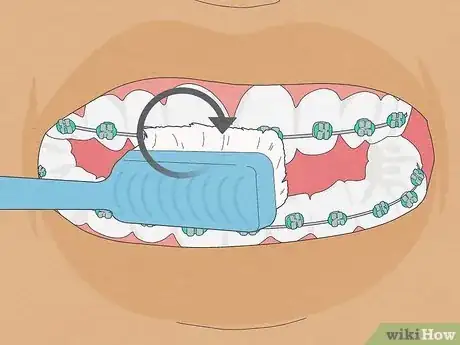
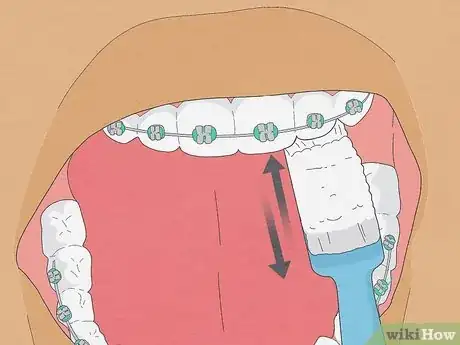

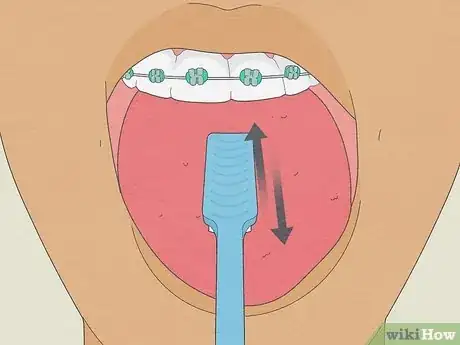

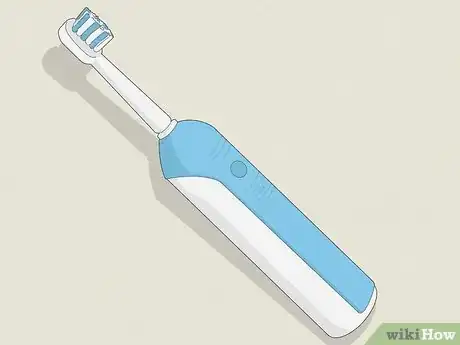
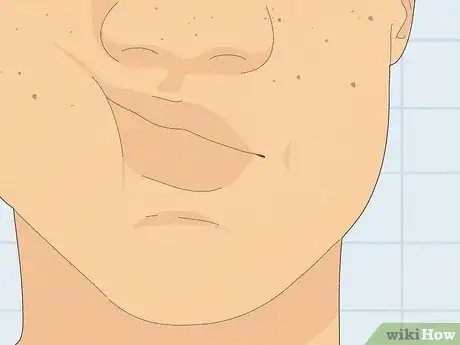

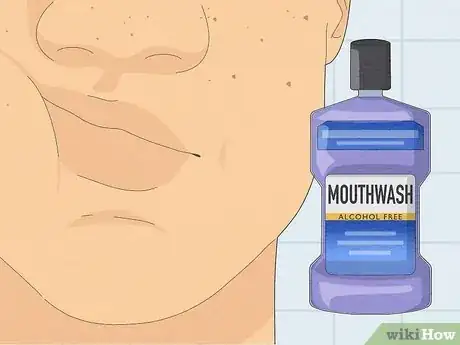
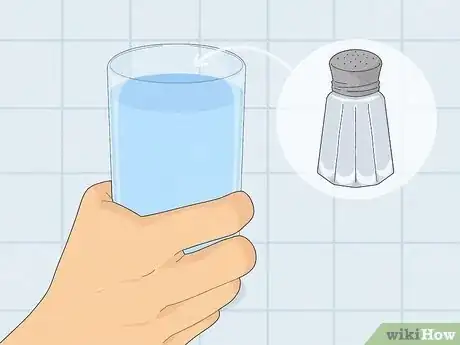
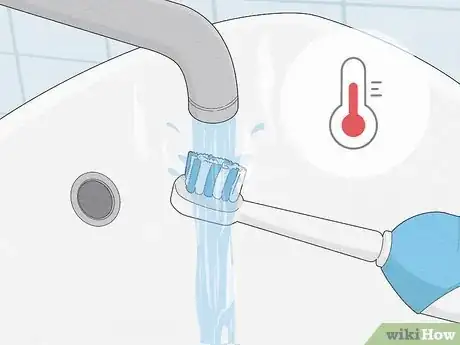
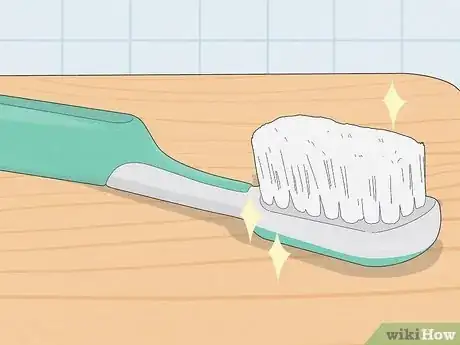
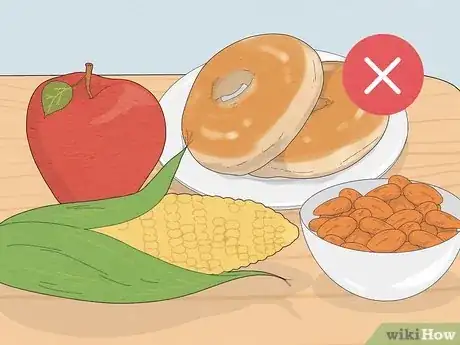
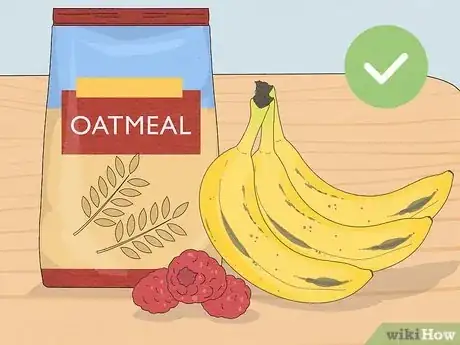
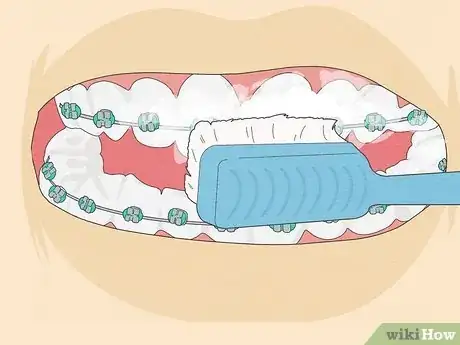


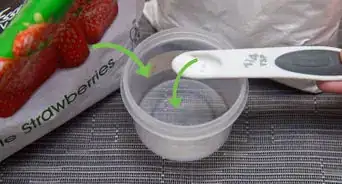

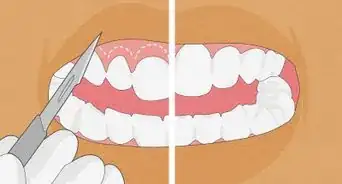
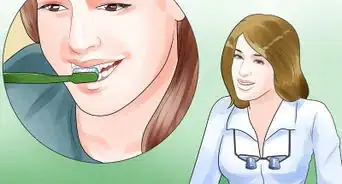
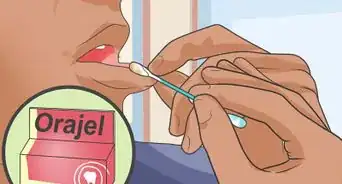


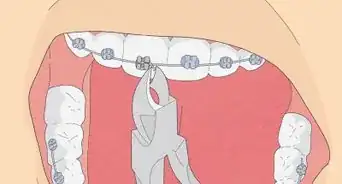

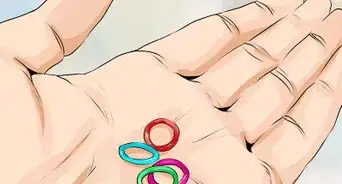
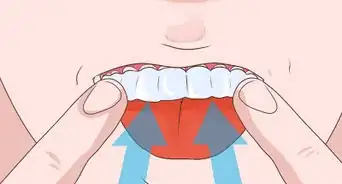
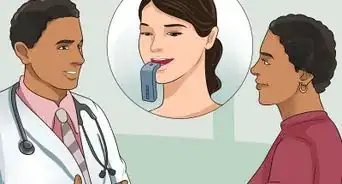
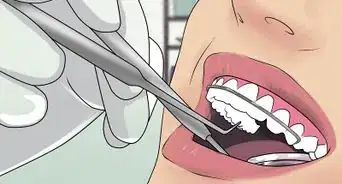










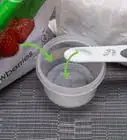

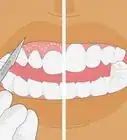



































Medical Disclaimer
The content of this article is not intended to be a substitute for professional medical advice, examination, diagnosis, or treatment. You should always contact your doctor or other qualified healthcare professional before starting, changing, or stopping any kind of health treatment.
Read More...